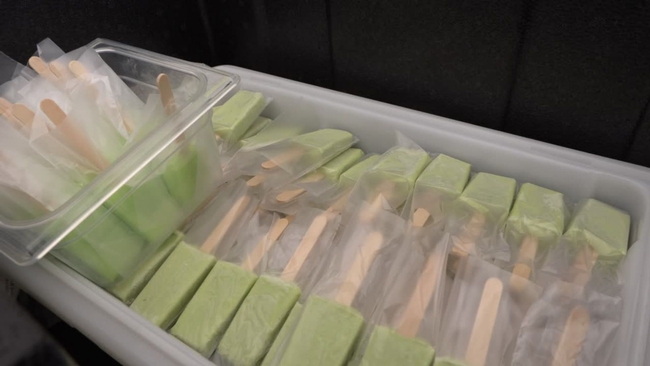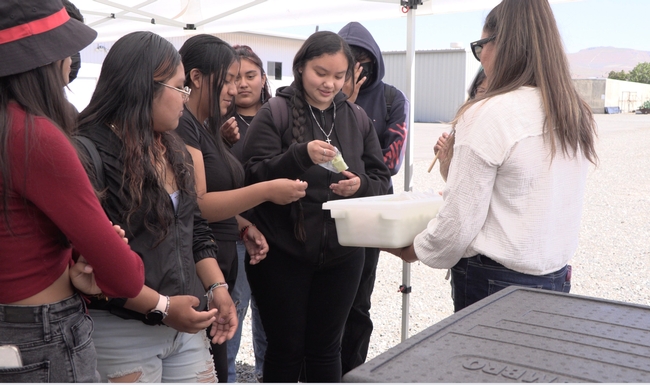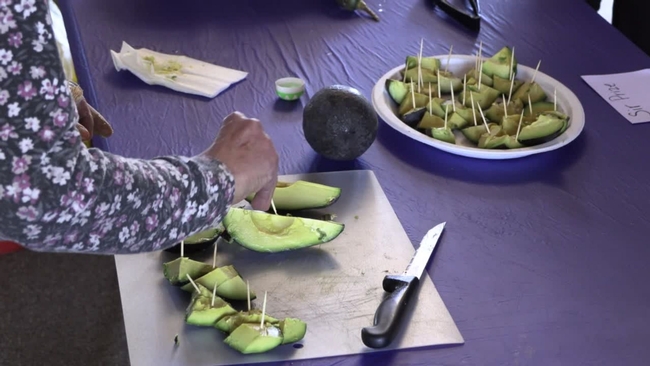On a hot day and after a long walk-through of farm fields full of citrus, onion, potato, avocado, and other fruits and vegetables, dozens of students stopped at a shade shelter to take a break and taste something that surprised them.
An avocado ice popsicle.
Yes, you read correctly, an avocado popsicle, without added sugars, made by hand in a nevería Spanish name for ice cream parlor located in Anaheim, California.
"Come and try them; we made them with the avocados donated by UC ANR (Agriculture and Natural Resources) South Coast Research and Extension Center," said Jennifer Clausen-Quiroz of Tocumbo Ice Cream, encouraging teens to try the popsicles.
“Avocado popsicles? They must taste like guacamole” was the first thing that came to mind for Jeffrey Magill, a Huntington Beach High School student.
"Upon learning that you can make ice cream with avocado, I thought you said guacamole, but I was wrong,” said Magill. “I don't even like avocados and love them. The avocado popsicle was amazing.”
Magill was one of about 100 students from several local schools who visited the UC ANR center as part of an educational trip through its GROW program. Tasting the popsicles was one of several activities they did throughout the day.
At South Coast REC, it is common to organize events for the community to try new varieties of fruits and vegetables that experts produce to improve taste, provide variety or simply grow plants more resistant to a challenging environment, drought, pests, etc.
For example, in the case of avocado, UC ANR has played a role in patenting about 9 or 10 different varieties of avocado since 1992.
At the REC, researchers have studied 230 more types of avocados (not all of which are UC varieties). Some come from Central American countries, and there are even wild varieties. Each one is different from the other. Some avocados have thicker or darker shells. Some are rounder; others are tiny. Others are sweeter or creamier.
All those different types are collected and studied to produce new flavors that might be introduced to the market for the judgment of the public's discriminating palates.
An education in food
The avocado is still a relatively new fruit in this country. It was considered an “ethnic food” only a few decades ago because it was consumed more by people with Mexican heritage. But that has changed, and demand continues to snowball throughout the country.
For Magill, trying the avocado popsicle was an experience that taught him not to be afraid to try new foods. "This gave me a reason to go and look for fruits that I dislike because you know there are a million ways you can have things," the student said.
Harvesting, tasting new foods, watching plants germinate, and talking to volunteers and experts about agriculture was part of the complete experience that the students had. The GROW program runs in collaboration with the Orange County Farmers Bureau, an organization that also helps fund educational activities. The purpose is to show where food comes from and the ample career opportunities in agriculture.
"Our goal is to attract them (students) to think that agriculture is definitely a career that interests me and see that there is a lot of science behind what is done to grow our food," said Darren Haver, director of UC South Coast REC, which has successfully collaborated with OCFB since the early 2000s.
The research center is nestled on 200 acres, where currently more than 35 different studies are being conducted to produce foods such as coffee and new varieties of avocado and other foods.
"In California, we produce 90% of the U.S. market (of avocados), but it's not enough for the whole country, maybe it's not enough for California itself," said Eric Focht, a UC Riverside expert in avocado cultivation and improvement, referring to the growing demand for this creamy fruit.
Focht explained that avocados have many textures and varieties, such as the Hass avocado, which is a bit firm and would be better for slicing. And then there is the Fuerte avocado, which is creamy and more suitable for making guacamole.
Fruit ice pops, a gift of the flavors of Mexico.
Guava, soursop, mango, passion fruit, lemon, chamoy with its picosito flavor, mamey, pistachio, and more are some of the popsicles of Tocumbo Ice Cream. They reflect the adventure of flavors familiar in Mexican culture.
A niche product born in Michoacán, fruit popsicles are over 100 years old and have become a very successful export product in the U.S.
Tocumbo Ice Cream's pledge is to make popsicles from everything that comes from the field, and, of course, the avocado in Southern California has center stage. The flavor of the avocado is as delicious in ice cream or popsicles as it is in guacamole.
“Amazing, definitely nothing you can expect,” said Maria Georgakopoulos, a Huntington Beach High School teacher. “They were very creamy and sweetened naturally and had no added sugar. We were all pleasantly surprised."
At the end of the GROW program and tour, Diana Chavez, one of the high school students, summed up what the students experienced at UC South Coast REC.
"The avocado popsicles are very good," she said. "And we've learned a lot about the different types of avocados."
*Adapted to English by Ricardo Vela from the Spanish blog ¿Paletas heladas de guacamole?


